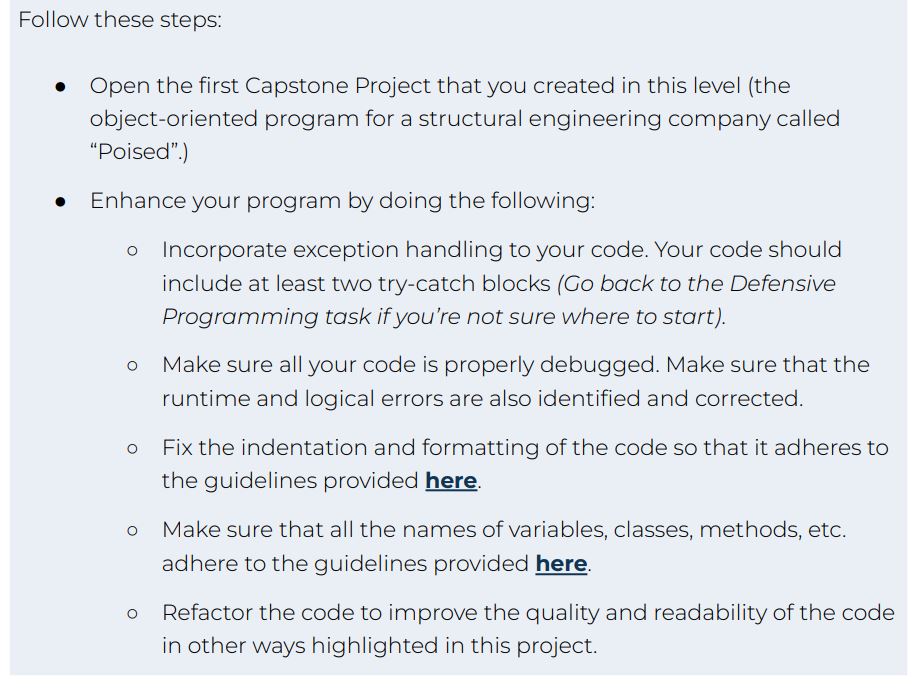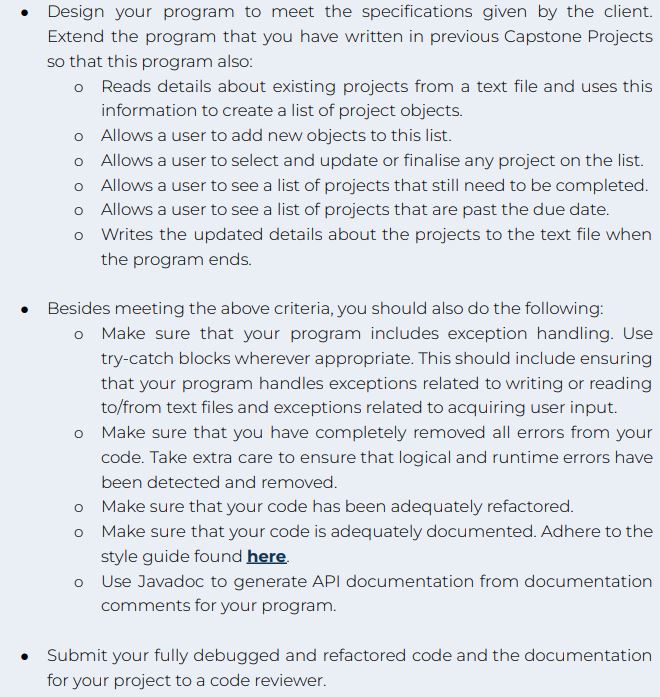Answered step by step
Verified Expert Solution
Question
1 Approved Answer
Follow these steps: Open the first Capstone Project that you created in this level (the object-oriented program for a structural engineering company called Poised.)



Follow these steps: Open the first Capstone Project that you created in this level (the object-oriented program for a structural engineering company called "Poised".) Enhance your program by doing the following: Incorporate exception handling to your code. Your code should include at least two try-catch blocks (Go back to the Defensive Programming task if you're not sure where to start). Make sure all your code is properly debugged. Make sure that the runtime and logical errors are also identified and corrected. Fix the indentation and formatting of the code so that it adheres to the guidelines provided here. Make sure that all the names of variables, classes, methods, etc. adhere to the guidelines provided here. Refactor the code to improve the quality and readability of the code in other ways highlighted in this project. Follow these steps: Code a Java program that will meet part of the client's specifications. You don't have to meet all the client's specifications at this stage. This Capstone project will be your first deliverable for Poised. You will build upon this program in later Capstone projects. For this program, you should: Create a class that will be used to create a project object. o Create a class that will be used to create person (e.g. architect, building contractor, etc.) objects. Write a program that will allow a user to: " Capture the details that are used to create a new project object. Change the due date of the project. Change the total amount of the fee paid to date. Update a contractor's contact details. Finalise the project (but don't worry about saving it to a text file yet). . Design your program to meet the specifications given by the client. Extend the program that you have written in previous Capstone Projects so that this program also: Reads details about existing projects from a text file and uses this information to create a list of project objects. Allows a user to add new objects to this list. Allows a user to select and update or finalise any project on the list. Allows a user to see a list of projects that still need to be completed. Allows a user to see a list of projects that are past the due date. Writes the updated details about the projects to the text file when the program ends. Besides meeting the above criteria, you should also do the following: Make sure that your program includes exception handling. Use try-catch blocks wherever appropriate. This should include ensuring that your program handles exceptions related to writing or reading to/from text files and exceptions related to acquiring user input. Make sure that you have completely removed all errors from your code. Take extra care to ensure that logical and runtime errors have been detected and removed. Make sure that your code has been adequately refactored. Make sure that your code is adequately documented. Adhere to the style guide found here. o Use Javadoc to generate API documentation from documentation comments for your program. Submit your fully debugged and refactored code and the documentation for your project to a code reviewer.
Step by Step Solution
There are 3 Steps involved in it
Step: 1

Get Instant Access to Expert-Tailored Solutions
See step-by-step solutions with expert insights and AI powered tools for academic success
Step: 2

Step: 3

Ace Your Homework with AI
Get the answers you need in no time with our AI-driven, step-by-step assistance
Get Started


